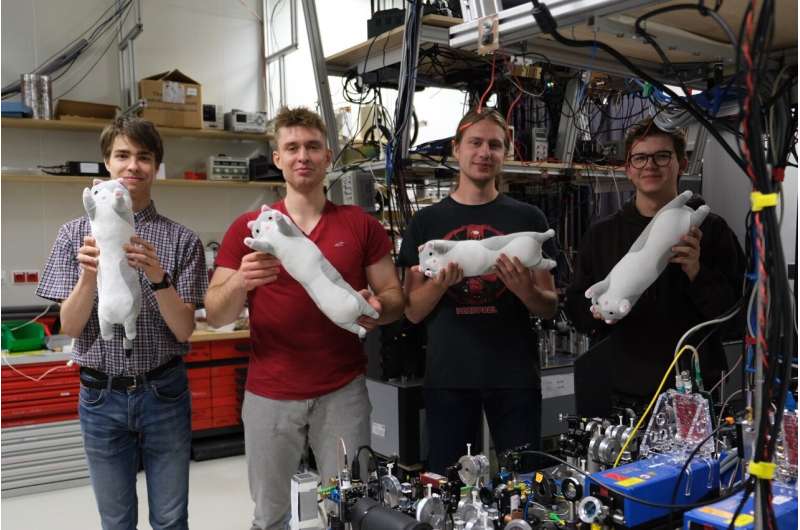This article has been reviewed according to Science X's editorial process and policies. Editors have highlighted the following attributes while ensuring the content's credibility:
fact-checked
peer-reviewed publication
trusted source
proofread
Research students turn Schrödinger's cat on its head

Students at the Faculty of Physics of the University of Warsaw (UW) and researchers from the QOT Center for Quantum Optical Technologies have developed an innovative method that allows the fractional Fourier Transform of optical pulses to be performed using quantum memory. This achievement is unique on the global scale, as the team was the first to present an experimental implementation of the said transformation in this type of system.
The results of the research were published in the journal Physical Review Letters. In their work, the students tested the implementation of the fractional Fourier Transform using a double optical pulse, also known as a "Schrödinger's cat" state.
The spectrum of the pulse and temporal distribution
Waves, such as light, have their own characteristic properties—pulse duration and frequency (corresponding, in the case of light, to its color). It turns out that these characteristics are related to each other through an operation called the Fourier Transform, which makes it possible to switch from describing a wave in time to describing its spectrum in frequencies.
The fractional Fourier Transform is a generalization of the Fourier Transform that allows a partial transition from a description of a wave in time to a description in frequency. Intuitively, it can be understood as a rotation of a distribution (for example, the chronocyclic Wigner function) of the considered signal by a certain angle in the time-frequency domain.
It turns out that transforms of this type are exceptionally useful in the design of special spectral-temporal filters to eliminate noise and enable the creation of algorithms that make it possible to use the quantum nature of light to distinguish pulses of different frequencies more precisely than traditional methods. This is especially important in spectroscopy, which helps study the chemical properties of matter, and telecommunications, which requires the transmission and processing of information with high precision and speed.
An ordinary glass lens is capable of focusing a monochromatic beam of light falling on it to almost a single point (focus). Changing the angle of incidence of light on the lens results in a change in the position of the focus. This allows us to convert angles of incidence into positions, obtaining the analogy of the Fourier Transform, in the space of directions and positions. A classical spectrometer based on a diffraction grating uses this effect to convert the wavelength information of light into positions, allowing us to distinguish between spectral lines.
Time and frequency lenses
Similarly to the glass lens, time and frequency lenses allow the conversion of a pulse's duration into its spectral distribution, or effectively, perform a Fourier transform in time and frequency space. The right selection of powers of such lenses makes it possible to perform a fractional Fourier Transform. In the case of optical pulses, the action of time and frequency lenses corresponds to applying quadratic phases to the signal.
To process the signal, the researchers used a quantum memory—or more precisely a memory equipped with quantum light processing capabilities—based on a cloud of rubidium atoms placed in a magneto-optical trap. The atoms were cooled to a temperature of tenths of millions of degrees above absolute zero (42 μK). The memory was placed in a changing magnetic field, allowing components of different frequencies to be stored in different parts of the cloud. The pulse was subjected to a time lens during writing and reading, and a frequency lens acted on it during storage.
The device developed at the UW allows the implementation of such lenses over a very wide range of parameters and in a programmable way. A double pulses is very prone to decoherence, hence it is often compared to the famous Schrödinger cat—a macroscopic superposition of being dead and alive, almost impossible to achieve experimentally. Still, the team was able to implement faithful operations on those fragile dual-pulse states.
Before direct application in telecommunications, the method must first be mapped to other wavelengths and parameter ranges. Fractional Fourier transform, however, could prove crucial for optical receivers in state-of-the-art networks, including optical satellite links. A quantum light processor developed at the UW makes it possible to find and test such new protocols in an efficient way.
More information: Bartosz Niewelt et al, Experimental Implementation of the Optical Fractional Fourier Transform in the Time-Frequency Domain, Physical Review Letters (2023). DOI: 10.1103/PhysRevLett.130.240801
Journal information: Physical Review Letters
Provided by University of Warsaw




















